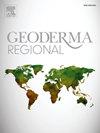硝化抑制剂对德国北部不同质地土壤中玉米锰和磷芽浓度的影响
IF 3.1
2区 农林科学
Q2 SOIL SCIENCE
引用次数: 0
摘要
土壤 pH 值过高会导致 Mn2+ 和 P 缺乏,从而导致作物减产。因此,向土壤提供稳定或非稳定的 NH4+-N 肥料可增加土壤中 Mn2+ 的供应量和芽的浓度。有人提出硝化抑制剂(NIs)可以降低根瘤土壤的 pH 值,从而提高植物对 P 的吸收,防止高 pH 值土壤中 P 的缺乏。因此,本研究调查了硝化抑制剂稳定或未稳定的 NH4+-N 能否提高三种不同质地土壤(沙土、壤土和粉砂质壤土)中的 Mn2+ 供应量,并促进玉米中 Mn2+ 和 P 的芽浓度。进行了两项温室试验,研究施用含有或不含硝化抑制剂 3,4-二甲基吡唑磷酸盐(DMPP)的 NH4+-N 肥料与不同氮源(硝酸钙(CN)、硝酸铵(AN)和硫酸铵(AS))结合的效果。测量的变量包括土壤容重和根圈土壤 pH 值、Mn2+ 可利用性、玉米生物量以及 Mn2+ 和 P 的芽浓度。结果表明,与未经稳定化的 AS 相比,经 DMPP 稳定化的 AS 能显著降低壤质砂土的根瘤层 pH 值 7.2%。同样,仅在壤土质地中,DMPP 稳定的 AS 与未稳定的 AS 相比,Mn2+ 的可用性和芽浓度分别提高了 86% 和 47%。此外,相对于未添加 DMPP 的相应氮源,经 DMPP 处理的 AS 和 AN 能使壤土和粉砂质土壤中的钾芽浓度分别提高 30% 和 21%。相反,对于所有氮源,DMPP 对沙土质地中的调查变量没有影响。此外,在沙质土壤中,与 CN 肥料相比,AN 和 AS 可使生物量产量、Mn2+ 可利用性和嫩枝浓度分别提高 72%、30% 和 46%。总之,本研究证实了 DMPP 诱导的根圈酸化能有效提高壤质砂土中 Mn2+和 P 的芽浓度,以及细粒土壤中 P 的芽浓度。本文章由计算机程序翻译,如有差异,请以英文原文为准。
Nitrification inhibitor effect on manganese and phosphorus shoot concentrations in maize under different textured soils from northern Germany
High soil pH can result in Mn2+ and P deficiency, leading to crop yield losses. Therefore, supplying soil with NH4+-N fertilizer in stabilized or unstabilized form can increase soil Mn2+ availability and shoot concentration. Nitrification inhibitors (NIs) have been proposed to lower rhizosphere soil pH, thus improving plant P uptake and preventing P deficiency in soils with high pH. Thus, this study investigated whether NI-stabilized or unstabilized NH4+-N could increase Mn2+ availability in three differently-textured soils (sand, loamy sand, and silt loam) and promote Mn2+ and P shoot concentration in maize. Two greenhouse experiments were conducted to investigate the effects of applying NH4+-N fertilizer with or without the nitrification inhibitor 3,4-dimethylpyrazole phosphate (DMPP) combined with different nitrogen (N) sources (calcium nitrate (CN), ammonium nitrate (AN), and ammonium sulphate (AS)). The measured variables were bulk and rhizosphere soil pH and Mn2+ availability, maize biomass, as well as Mn2+ and P shoot concentrations. The results indicated that DMPP-stabilized AS significantly decreased rhizosphere pH by 7.2 % in loamy sand soil texture compared with unstabilized AS. Similarly, only in the loamy sand texture, DMPP-stabilized AS increased Mn2+ availability and shoot concentration by 86 % and 47 %, respectively, relative to unstabilized AS. Furthermore, DMPP-treated AS and AN promoted P shoot concentration by 30 % and 21 % in the loamy sand and silt loam soil textures, respectively, relative to the corresponding N sources without DMPP. Conversely, DMPP did not impact the investigated variables in the sand texture for all N sources. Moreover, AN and AS increased biomass yield, Mn2+ availability, and shoot concentration by 72 %, 30 %, and 46 %, respectively, in relation to the CN fertilizer in the sand soil texture. In conclusion, this study confirmed the effectiveness of DMPP-induced rhizosphere acidification in enhancing Mn2+ and P shoot concentration in loamy sand soil textures, as well as P shoot concentration in fine-textured soil.
求助全文
通过发布文献求助,成功后即可免费获取论文全文。
去求助
来源期刊

Geoderma Regional
Agricultural and Biological Sciences-Soil Science
CiteScore
6.10
自引率
7.30%
发文量
122
审稿时长
76 days
期刊介绍:
Global issues require studies and solutions on national and regional levels. Geoderma Regional focuses on studies that increase understanding and advance our scientific knowledge of soils in all regions of the world. The journal embraces every aspect of soil science and welcomes reviews of regional progress.
 求助内容:
求助内容: 应助结果提醒方式:
应助结果提醒方式:


